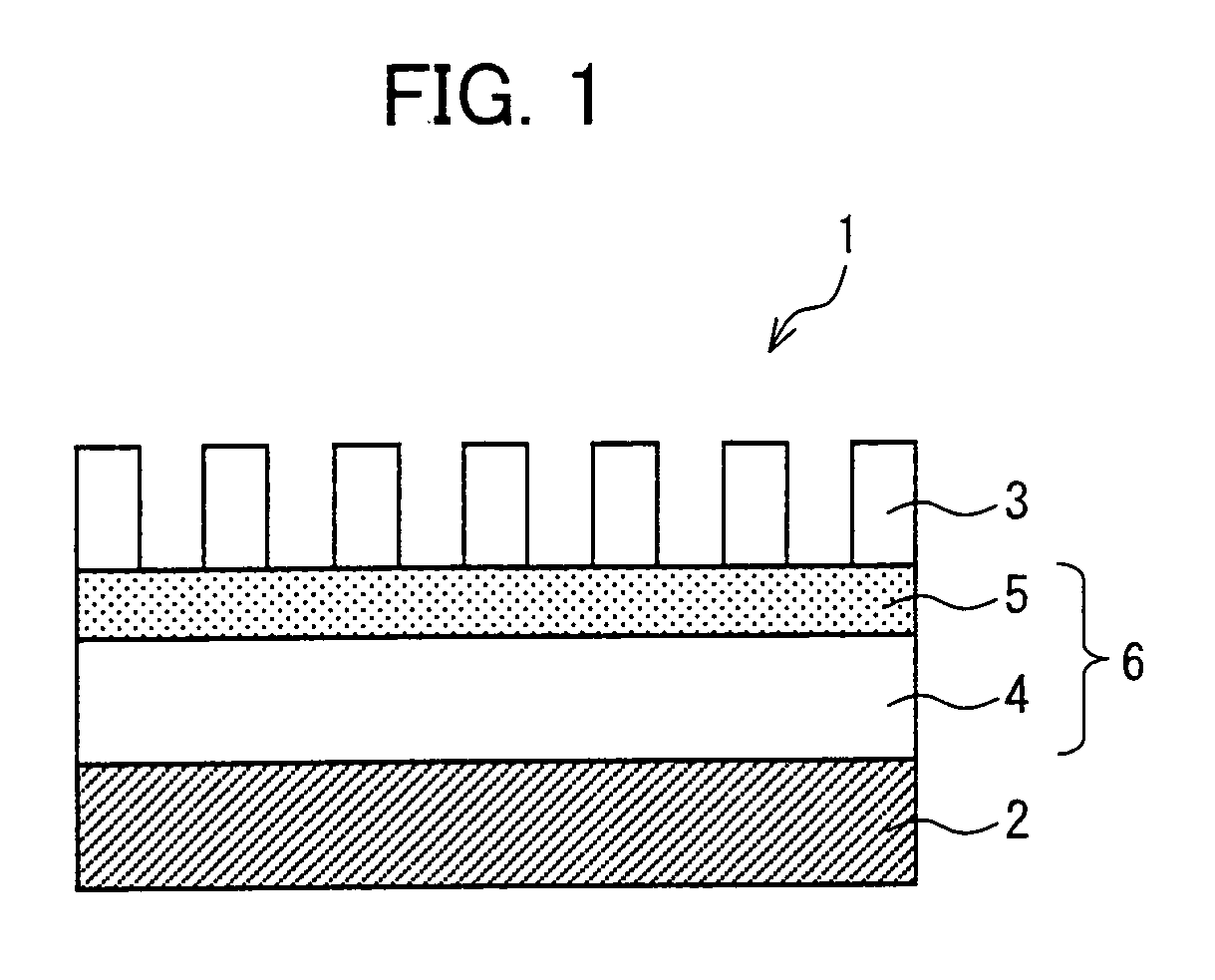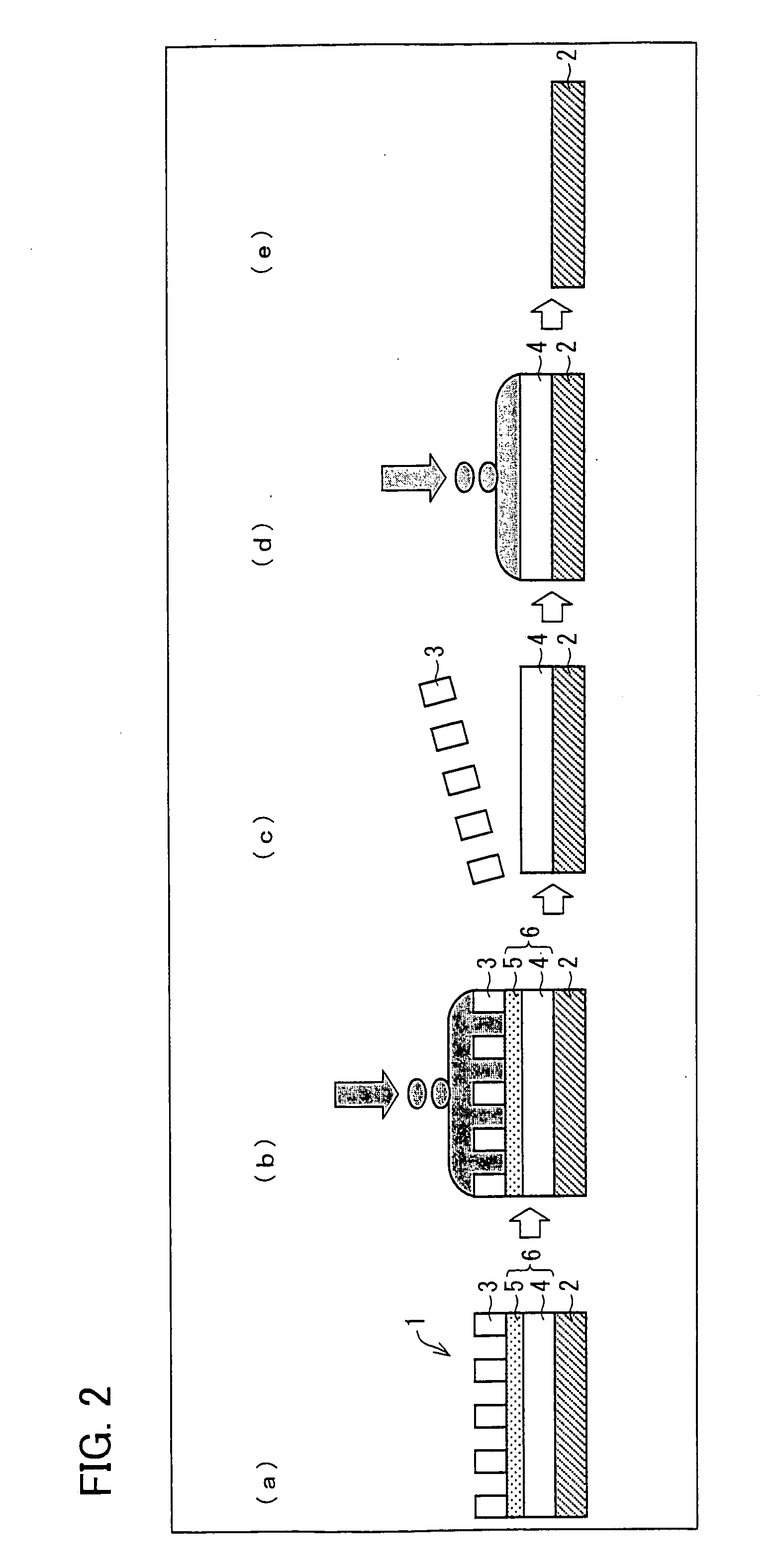Removal method, adhesive agent for substrate, and laminate including substrate
- Summary
- Abstract
- Description
- Claims
- Application Information
AI Technical Summary
Benefits of technology
Problems solved by technology
Method used
Image
Examples
example 1
[0086]An adhesive compound 1 was applied onto a 5-inch silicon wafer 2 and then dried at 80° C. for 5 minutes, so as to form a first adhesive layer 4 having a film thickness of 15 μm. Subsequently, an adhesive compound 2 was applied onto the first adhesive layer 4 and then dried at 80° C. for 5 minutes, so as to form a second adhesive layer 5 having a film thickness of 3 μm. Then, a pored support plate 3 was attached on the second adhesive layer 5.
[0087]HP was poured onto a laminate 1 formed in the above way, from above the support plate 3. To HP, the second adhesive layer 5 had a solution rate of 200 nm / sec. After the second adhesive layer 5 was dissolved, the support plate 3 was removed, and HP was poured onto an entire surface of the first adhesive layer 4. To HP, the first adhesive layer had a solution rate of 100 nm / sec. It took approximately 60 seconds to dissolve the first adhesive layer 4, and approximately 2 minutes and 30 seconds to dissolve the support plate 3.
example 2
[0088]In a same way as Example 1, the adhesive compound 1 was applied onto a 5-inch silicon wafer 2, and dried at 80° C. for 5 minutes, so as to form a first adhesive layer 4 having a film thickness of 15 μm. On the first adhesive layer 4, subsequently, a solution of collagen peptide (a solution of collagen peptide having 30 mass %) was applied and dried at 80° C. for 5 minutes, so as to form a second adhesive layer 5 having a film thickness of 3 μm. Then, a pored support plate 3 was attached on the second adhesive layer 5.
[0089]Water was poured onto a laminate 1 formed in the above way, from above the support plate 3. To water, the second adhesive layer 5 had a solution rate of 340 nm / sec. After the second adhesive layer 5 was dissolved, the support plate 3 was removed, and HP was poured onto an entire surface of the first adhesive layer 4. To HP, the first adhesive layer 4 had a solution rate of 100 nm / sec. It took approximately 60 seconds to dissolve the first adhesive layer 4, a...
example 3
[0090]An adhesive compound 1 was applied onto a 6-inch silicon wafer 2 and dried at 110° C. for 3 minutes and then at 150° C. for 6 minutes, so as to form a first adhesive layer 4 having a film thickness of 30 μm. Subsequently, a p-menthane solution (30 mass %) containing a hydrogenerated terpene resin (YASUHARA CHEMICAL Co., Ltd) was applied onto the first adhesive layer 4 and dried at 120° C. for 3 minutes, so as to form a second adhesive layer 5 having a film thickness of 7 μm. Then, a pored support plate 3 was attached on the second adhesive layer 5.
[0091]p-menthane was poured onto a laminate 1 formed in the above way, from above the support plate 3. To p-menthane, the second adhesive layer 5 had a solution rate of 400 nm / s. After the second adhesive layer 5 was dissolved, the support plate 3 was removed, and HP was poured onto an entire surface of the first adhesive layer 4. To HP, the first adhesive layer had a solution rate of 100 nm / s. It took approximately 60 seconds to dis...
PUM
| Property | Measurement | Unit |
|---|---|---|
| Fraction | aaaaa | aaaaa |
| Temperature | aaaaa | aaaaa |
| Temperature | aaaaa | aaaaa |
Abstract
Description
Claims
Application Information
 Login to View More
Login to View More - R&D
- Intellectual Property
- Life Sciences
- Materials
- Tech Scout
- Unparalleled Data Quality
- Higher Quality Content
- 60% Fewer Hallucinations
Browse by: Latest US Patents, China's latest patents, Technical Efficacy Thesaurus, Application Domain, Technology Topic, Popular Technical Reports.
© 2025 PatSnap. All rights reserved.Legal|Privacy policy|Modern Slavery Act Transparency Statement|Sitemap|About US| Contact US: help@patsnap.com



